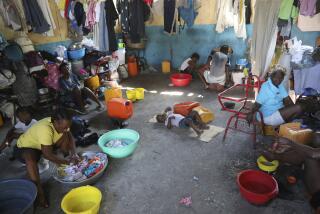Helping Haiti help itself
- Share via
Haitians have long been prey to hurricanes and coups, their nation ravaged by erosion and corruption, mudslides and marauders, poverty and violence. Now the few economic and political gains made over five years of relative stability have been buried along with thousands of corpses in the rubble of a magnitude 7.0 earthquake. The presidential palace, parliament, government ministries and hospitals -- indeed most of the capital of Port-au-Prince -- are in ruins. An already dysfunctional state now lacks even the edifices of government. Gone too are some of the buttresses: the archbishop and his cathedral; the head of the United Nations mission and some of his top aides, who died when their headquarters collapsed.
Not even a developed country could completely withstand such a powerful temblor so close to the Earth’s surface and city center. Yet the full extent of Haiti’s devastation is a result of its broken state, where 80% live below the poverty line. Port-au-Prince quadrupled to nearly 3 million people in the last 25 years as Haitians fled a denuded countryside in search of food and work. They built shanties out of watered-down concrete on precarious hillsides. They didn’t have water and electricity, let alone zoning and inspectors to insist on safety. The international community has made some headway in building a civilian police force to provide security, but not as much in bolstering a civilian government to provide for its people. A school to train magistrates was to reopen this month; parliamentary elections were to be held in March and a presidential election in December. Tentative investments were trickling in to tourism and industry. All of that came to a screeching halt in seconds.
Of course the United States and the international community must respond to the terrible emergency first. They must tend to the wounded, provide shelter for tens of thousands of homeless and bury the dead. But they also must plan now for rebuilding the capital and, even harder still, creating a functioning state. Yes, that’s nation-building. It is the urban planning that never took place. It means working with the government to build adequate housing and schools. It requires job creation -- and not necessarily in the capital. This is an agricultural country that must be able to farm and feed itself.
For decades, the United States has turned its attention to Haiti only sporadically, only in times of crisis, when too many boatloads of hungry Haitians washed onto Florida shores or when a government was about to fall -- but then lost interest to another crisis. If the U.S. has the will and resources to build up governments in Afghanistan, Iraq, even Yemen, surely it can show leadership in building a functioning country on an island just a few hundred miles from the coast of Florida. Enough is enough for this failed state.
More to Read
Sign up for Essential California
The most important California stories and recommendations in your inbox every morning.
You may occasionally receive promotional content from the Los Angeles Times.










